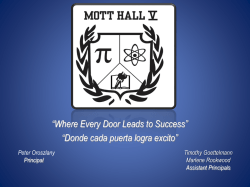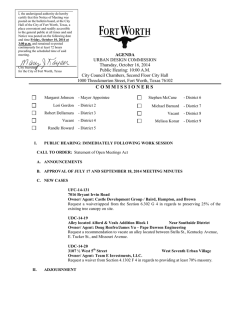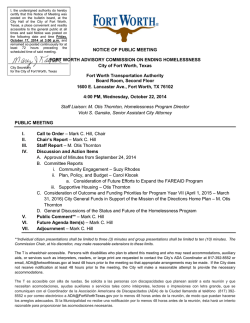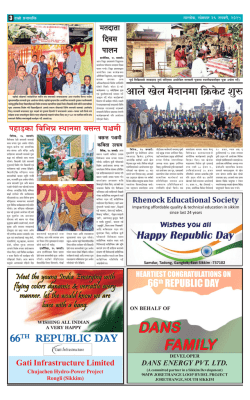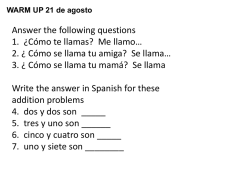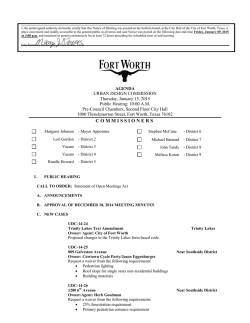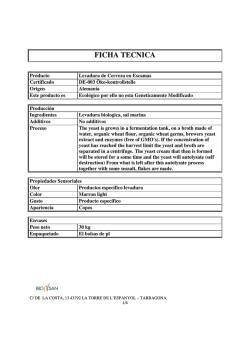
Integrated numerical platforms for environmental dose assessments
39ª Reunión Anual de la SNE Reus (Tarragona) España, 25-27 septiembre 2013 Integrated numerical platforms for environmental dose assessments of large tritium inventory facilities P. Castro1, J. Ardao2, M. Velarde3, L. Sedano 4,1, J.Xiberta4 1 2 3 CIEMAT, Laboratorio Nacional de Fusión, Avda Complutense,22. 28040 Madrid, Agencia Estatal de Meteorología, AEMET Leonardo Prieto Castro s/n 28071-Madrid, DENIM/ETSIM, Univ. Politécnica de Madrid, C/ José Gutiérrez Abascal, 2 28006 Madrid(*) 4 Depto. de Energía/ETSIMO, Universidad de Oviedo. Independencia, 13 33004, Oviedo [email protected] Resumen – En relación al nuevo escenario anticipado de instalaciones con inventario grande de tritio [como el KATRIN en el TLK, los CANDUs, el ITER, EAST, y otros] los límites dosimétricos de la ICRP-60 para dosis-comprometidas están en discusión. Se requiere, en paralelo, superar cálculos muy conservadores ajustando los cálculos dosimétricos en muchos aspectos. Se puede llegara a cálculos precisos de la dosimetría por modelos-lagrangianos de evolución de nubes de tritio que son emitidas en casos de operación normal/incidental/SBO. Están abiertas a cálculos numéricos en tiempo-real en base a datos meteorológicos y a diversos patrones de datos a diferentes escalas que posteriormente inciden en los cálculos de dosis crónicas por tritio. La dirección hacia plataformas-numéricas-integradas para el cálculo del impactomedioambiental de instalaciones con grandes-inventarios-de-tritio está en desarrollo. Abstract - Related with a prospected new scenario of large inventory tritium facilities [KATRIN at TLK, CANDUs, ITER, EAST, other coming] the prescribed dosimetric limits by ICRP-60 for tritium committed-doses are under discussion requiring, in parallel, to surmount the highly conservative assessments by increasing the refinement of dosimetric-assessments in many aspects. Precise lagrangian-computations of dosimetric cloud-evolution after standardized (normal/incidental/SBO) tritium cloud emissions are today numerically open to the perfect match of real-time meteorologicaldata, and patterns data at diverse scales for prompt/early and chronic tritium dose assessments. The trends towards integrated-numerical-platforms for environmentaldose assessments of large tritium inventory facilities under development. 1. INTRODUCTION As well-known principle, total safety has infinite costs as well as the system design consideration of a large number of confinement barriers and safety systems redundancy for the implementation of the ALARA principle in the design of facilities managing tritium inventories in the range of kilograms (case of ITER). Related with a prospected new scenario of large inventory tritium facilities [KArlsruhe TRItium Neutrino (KATRIN) at Tritium 39ª Reunión Anual de la SNE Reus (Tarragona) España, 25-27 septiembre 2013 Laboratory Karlsruhe, CANDUs at Canada, ITER at France, Experimental-AdvancedSuperconducting-Tokamak EAST, other coming] the prescribed dosimetric limits (by ICRP60) for tritium committed doses are under discussion requiring, in parallel, to surmount the highly conservative assessments by increasing the refinement of dosimetric assessments in many aspects. Precise computations of dosimetric cloud evolution after standardized (normal/incidental/SBO) Tritium forms (HT, HTO) emissions are today numerically open to the perfect match of real-time meteorological data, GIS data, agricultural, demographic and socioeconomic patterns data at diverse scales for prompt/early and chronic tritium dose assessments. The trends towards integrated numerical platforms for environmental dose assessments of large tritium inventory facilities under development and its main numerical and hardware characteristics are presented in this paper. Following Castro, Velarde et al, short-term releases of tritium hydride (HT) to the atmosphere from a potential ITER-like fusion reactor located in the Mediterranean Basin and short range legal exposure limits are not exceeded (both locally and downwind) with a coupled Lagrangian ECMWF/FLEXPART model used to follow real time releases of tritium [1-4,6]. This tool was analyzed for nominal tritium operational conditions under selected incidental conditions –e.g. in the case of a little Tritium-Extraction-System (TES) pipe break (with critical failure of a fuelling line), the tritium source term - in the frame of European Test Blanket Systems- is expected to be in the order of a few grams. In this critical scenario acute modeling of environmental tritium transport forms (HT and HTO) for the assessment of fusion facilities dosimetric impact has been made assumed a hypothetical daily release of one gram of tritium in HT form and 0,1 gram in HTO form. [7] The daily failure was taken just in order to evaluate different meteorological scenarios or weather conditions. The early steps or trends towards integrated-numerical-platforms for environmental-dose assessments of large tritium inventory facilities under development are briefly described in this paper. Figure. 1. Staheholders or Members to continue platform integration The final platform will require the works of the all stakeholders shown in figure 1 for the preprocess, the coupling of ECMWF/FLEXPART and the post-process of the output products of HT and HTO. In addition to these members the UPM verified this model by comparison NORMTRI and the results were published in [8] for a pattern of tritium clouds specified in detail by P.Castro, M.Velarde, J.Ardao, J.L Perlado and L.A Sedano The lagrangian trajectories of tritium form clouds achieve ranges of several kilometers far from reactor or fusion facility as shown in the HT concentration products. Another previous studies were 39ª Reunión Anual de la SNE Reus (Tarragona) España, 25-27 septiembre 2013 already made as explained in [9] with a year data base of tritium products analised by CIEMAT (P.Castro et al.). To summarise: (1) The pre-process is an interface that transforms the output weather anaysis/forecast files for each point of the planet in other height files that Flexpart can use. (2) The calculus is made by a model of contaminants transport of Lagrangian type and (3) the post-process is a graphical package based in magics. (Note In the figure 1other postprocess is mention concerning the research required after receiving the products). Except of pre-process, the other 2 following steps can be installed and achieved in other Workstation or computer in CIEMAT in AEMET or in the Central or Fusion Facility itself. 2. MAGICS METEOROLOGICAL PLOTTING SOFTWARE WITH ECMWF AEMET uses MAGICS v.6 for the pre-process and coupling ECMWF and Flexpart v6.2. Actually Magics++ is the latest generation of the ECMWF's Meteorological plotting software MAGICS. Completely redesigned in C++, it is compatible as possible with the Fortran interface. (These means contour package was rewritten and no longer depends on the CONICON licence). Magics v6’s programming interfaces are Fortran and C. Magics++ offers MagML, a plot description language based on XML.The library supports the plotting of contours, wind fields, observations, satellite images, symbols, text, axis and graphs [4]. Data fields to be plotted may be presented in various formats, for instance GRIB 1 and 2 code data, gaussian grid, regularly spaced grid and fitted data. GRIB data is handled via ECMWF's GRIB API software. Input data can also be in BUFR and NetCDF format or retrieved from an ODB database. The produced meteorological plots can be saved in various formats, our products in selected areas as figure 2 (after copling with Flexpart) of HT are JPEG but may be also PostScript, EPS, PDF, GIF, or PNG. Figure 2. Areas selected in ECMWF within Magics and ECMWF vertical resolution (BL). 39ª Reunión Anual de la SNE Reus (Tarragona) España, 25-27 septiembre 2013 3. NEW FLEXPART TRITIUM FORMS PRODUCTS IN MAGICS: THE LITTLE TRITIUM CLOUDS FROM FUSION FACILITIES The HT and HTO in the areas selected in figure 2 are available at CIEMAT from 3 to 24 hours forecast. The source term is fixed [ref 6]. The outputs concentrations (in Bqm-3) and Dry and Wet depositions are not based in limited area models (as other Flexpart.eu members have made) but in the ECMWF. Figure 3. Little Tritium clouds in ECMWF/FLEXPART products HT Wet deposition (left) and concentrations of HT (right) Depositions are available in Bqm-2s-1 in the same periods of concentrations of Ht and HTO. Figure 3 show examples of these products with isolines of kBq/m3 and wet depositions of units of Bqm-2s-1 4. A DAILY TRIPLE PROCESS AEMET-ECMWF(FLEXPART)-CIEMAT Figure 4. Outputs of the batch job to the IBM cluster main ecgate output sent by email to CIEMAT in a daily basis. Example of email for etmod 2 39ª Reunión Anual de la SNE Reus (Tarragona) España, 25-27 septiembre 2013 To summarise every day there is a exchange or process of interaction between AEMETECMWF(FLEXPART) and CIEMAT, by automated systems. The mentioned HT or HTO wet depositions are available together with concentrations of HT or HTO and a set of ascii files with the output values of maximum concentrations by means of daily batch jobs in the IBM cluster main ecgate –after pre-process-. When batch jobs are finished they are programmed to be sent by email to CIEMAT in a daily (night) basis. The name of both zip files is etmod1.zip corresponding to HT products and etmod2.zip for HTO products. The exact date is indicated in the email. Also the name of the corresponding batch job can be different, in this case is ecga05.ecmwf.int for etmod 2 prepared in AEMET by meteorologist Jose Ardao Berdejo and sent to CIEMAT for further research and analysis (figure 4). In othe cases may be ecga01.ecmwf.int for etmod1.zip or another free gate may be used for one or other zip file. 5. FLEXPART WIND TRAJECTORIES FOR 20000 PARTICLES Figure 5. Example of flexpart wind trajectories with 20000 particles and wind velocity with turbulence and taking into account selected area The FLEXPART allows calculating the wind trajectories for a number of particles. Here the selected number is 20.000. The FLEXPART is a dispersion and transport model of Lagrangian type. The particles allow several species (as HT and HTO). The velocity is taking turbulence into account and also the selected area. In addition a stochastic family or number of trajectories is calculated by the model. (Figure 5) 6. OUTPUT TRITIUM PRODUCTS IN FORM OF HT: ETMOD1.ZIP FILE Figure 6 shows the set of files contained within etmod1.zip received every day. There are HT concentrations in 10 m , 30 m and 60 m height and also dry and wet depositions at mean sea level for a selected temporal range with a frequency of 3 hours. The ascii files 39ª Reunión Anual de la SNE Reus (Tarragona) España, 25-27 septiembre 2013 contains maximum concentrations in the 3 levels (Maxima.txt) maximum dry and wet depositions (MAXIMAS.txt and MAXIMAW.txt files) Figure 6. Set of files contained within etmod1.zip received every day Figure 7. Maxima HT concentration in air at three levels and the coordinates of cloud evolution in 24 hours Figure 7 maximum concentrations in the 3 levels (Maxima.txt) and the forecast coordinates of cloud evolution from 3 to 24 hours by FLEXPART lagrangian model. The absolute maxima corresponds to the release in 3 hours at the level of 10 m. With these values the obtaining of positions is easy and also the calculation of CEDE for the most exposed individual, at least by inhalation. These calculations actually belong to the post-process made mainly in Ciemat. These final steps and the selection of proper DCF for fusion should be defined to really achieve the total integration. The final platform should be useful already for other future Fusion facilities (DEMO included) and the large tritium inventory facilities as CANDUS and tritium laboratories in KIT, CEA or JAEA. 39ª Reunión Anual de la SNE Reus (Tarragona) España, 25-27 septiembre 2013 Fiigure 8. The HT concentrations in air over Vandellós and ITER Cadarache In figure 8 a comparison between the HT concentrations in air over Vandellós and Cadarache is presented. All daily values under isoline of 1MBq/m3 , Cadarache presents major values after 6 hour than Vandellos in this example. 7. CONCLUSIONS The trends toward integrated-numerical platforms for environmental-dose assesment of ITER are ongoing based in other Fusion Facilities (FF) as Vandellós ITER-like. The trends toward similar integrated-numerical platforms for environmental-dose assesment of large tritium inventory facilities (including FF and Tritium Laboratories with anthropogenic emission tracers) can be made - with stakeholder/s - in future with other developments and corresponding bach jobs to the IBM cluster main ecgate outputs. The future validation of those developments should be designed in a case by case basis (both with data and/or models). REFERENCES [1] Iain Russell, Stephan Siemen, Fernando Li,Sándor Kertész, Sylvie Lamy-Thépaut, Vesa Karhila Metview 4 – ECMWF’s latest generation meteorological workstation. ECMWF Newsletter No. 126 – Winter 2010/1123. 39ª Reunión Anual de la SNE Reus (Tarragona) España, 25-27 septiembre 2013 [2] Stephan Siemen, Fernando Li, Iain Russell, Metview Macro –A powerful meteorological batch language ECMWF Newsletter (No. 125, Autumn 2010, 30–32) [3] Sylvie Lamy-Thépaut Stephan Siemen, Meteorological Visualisation Section ECMWF Migration of MAGICS 6 to Magics++, 2012 [4] http://www.ecmwf.int/publications/magics [5] Flexpart Training Course Handbook, April 2013 [6] Castro, M. P.; Velarde, M.; Ardao, J.; Perlado, J. M.; Sedano, L. A , Little Tritium Extraction System Pipe Break Environmental Impact by Atmospheric modelling of elemental Tritium Gas and HTO transport, P2-116 . FUSENGDES-D-13-00377 Sep 08, 2013 Actual Status (With Editor) [7] P. Castro,M. Velarde, J. Ardao, J.M. Perlado, L. Sedano, Tritium clouds environmental impact in air into the Western Mediterranean Basin evaluation, FED Fusion Engineering and DesignVolume 87, Issues 7–8, August 2012, Pages 1471–1477Tenth International Symposium on Fusion Nuclear Technology (ISFNT-10) Edited By M. Akiba, P. Batistoni, K. Feng, P.W. Humrickhouse, B.J. Merrill, M. Shimada, Y. Wu, M.A. Abdou and M. Sawan [8] P. Castro, M. Velarde, J. Ardao, M. Perlado, L. A. Sedano, Validation of Real Time Dispersion of Tritium over the Western Mediterranean Basin in Different Assessments,Fusion Science and Technology / Volume 61 / Number 1T / Pages 355-360, January 2012. [9] Castro, P. y Velarde Mayol, Marta y Ardao, Jose y Perlado Martin, Jose Manuel y Sedano, Luis, Consequences of different meteorological scenarios in the environmental impact assessment of tritium in air (2011) Fusion Science and Technology , 60 (4). 1284 - 1287. ISSN 1536-1055
© Copyright 2025
